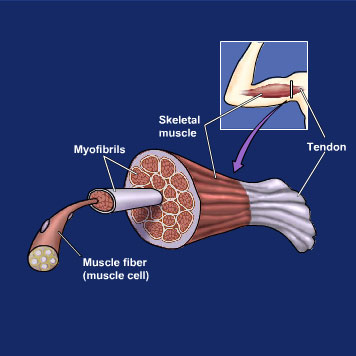Consider the swimmer or weight-lifter who might use anabolic steroids1 (in fact both swimmers and weight-lifters in the 2000 Olympics were disqualified for steroid use). They have larger, more powerful arm muscles due to an increased production of specific proteins contained within skeletal muscle. A review of muscle structure will help us understand how this happens.
There are three main types of muscle in the body – skeletal, smooth, and cardiovascular. Steroids work predominantly on skeletal muscles, which account for approximately 40% of the 630 muscles in the human body!! Skeletal muscle cells contain a contractile mechanism that is activated by an electrical impulse generated when the neurotransmitter, acetylcholine2, binds to acetylcholine receptors3 on the muscle (see Module 4). A single skeletal muscle cell is known as a muscle fiber (Figure 7).
Figure 7 A skeletal muscle cell (also called a muscle fiber) is shown containing several myofibrils. These protein filaments are important to muscle contraction.

The term muscle refers to a number of muscle fibers bound together by connective tissue known as tendons, which are located at each end of the muscle. Skeletal muscle fibers (cells) appear striated because of an organized arrangement of thick and thin protein filaments (myofibrils4) within cylindrical bundles in the cytoplasm–these myofibrils fill up most of the cytoplasm and extend from one end of a fiber to the other end. Each myofibril contains a repeating pattern of the thick and thin filaments surrounded by the sarcoplasmic reticulum and the sarcoplasm (cytoplasm). One unit of this repeating pattern is called a sarcomere5 (Figure 8). The thick filaments are composed of the contractile protein myosin6 and the thin filaments are composed of the contractile protein actin7. Contraction occurs when the sarcomeres shorten by the action of the myosin filaments sliding over the actin filaments. The sliding of the myosin filaments is initiated when acetylcholine binds to its receptor in the muscle cell, generating an electrical signal to release calcium from the sarcoplasmic reticulum (where it is sequestered) into the sarcoplasm. The muscle relaxes when the calcium is removed from the sarcoplasm back into the sarcoplasmic reticulum by the enzyme8 calcium-ATPase. The calcium-ATPase is often referred to as the “calicum pump”. It requires energy to do its job, so it hydrolyses ATP to generate the energy to actively transport the calcium back into the sarocplasmic reticulum.
Figure 8 The repeating pattern of thick and thin filaments is a sarcomere. The presence of calcium causes sarcomeres to shorten when actin filaments slide over the myosin filaments. This produces muscle contraction.

Anabolic steroids will induce the genetic machinery (as discussed in the previous section) in muscle cells to synthesize more muscle proteins. More contractile proteins make the muscle cell bigger, and therefore, the whole muscle gets bigger. Muscle growth is aided by another important action of anabolic steroids. Anabolic steroids can also bind to glucocorticoid receptors (there is some similarity in the structure of androgen9 and glucocorticoid receptors), preventing glucocorticoids from carrying out their normal catabolic10 or muscle-breakdown activity. Athletic performance improves as the muscles grow. The performance-enhancing effects of anabolic steroids do not occur in people who are not exercising unless large doses are used. Athletes tend to believe that the more steroids they take, the bigger their muscles will become. However, this doesn’t happen. There are only a finite number of steroid receptors in the muscle cell. Thus, when all of the receptors are bound to the steroid (i.e., the receptors become saturated), any additional steroid molecules remain in the bloodstream, where they travel to the liver and kidneys. The high levels of steroids presented to the liver and kidneys can cause damage. High doses of anabolic steroids can have other adverse effects too. They can actually increase protein breakdown during the muscular stress that occurs with intense athletic training, increase fluid and electrolyte retention, or produce an increase in body weight.
Definitions:
1 synthetic versions of testosterone designed to promote muscle growth without producing androgenic effects. The better term is anabolic-androgenic steroid.
2 a neurotransmitter stored in vesicles of nerve terminals; it is found in neurons within the central nervous system, the somatic nervous system, the parasympathetic nervous system and the sympathetic nervous system.
3 a protein to which hormones, neurotransmitters and drugs bind. They are usually located on cell membranes and elicit a function once bound.
4 a repeating pattern of thick (myosin) and thin (actin) protein filaments that are organized in cylindrical bundles within the sarcoplasm. The myofibrils extend from one end of a muscle fiber to the other end.
5 one unit of a repeating pattern of actin and myosin present in a myofibril.
6 contractile protein that is present in the thick filaments of the myofibrils.
7 contractile protein that is present in the thin filaments of the myofibrils.
8 a protein that catalyzes the rate at which a reaction occurs. It binds to one of the reactants (a substrate) to cause a change in the reactant’s structure, facilitating the reaction.
9 a steroid hormone such as testosterone that is masculinizing (deepens voice, produces facial & chest hair, sperm production
10 a compound that causes the breakdown of muscle resulting in the net loss of nitrogen from the body. Glucocorticoids are catabolic in skeletal muscle.

